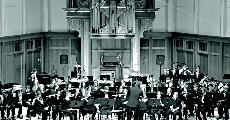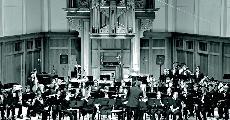
(Nhi Ngyuen)
Soaring, lyrical lines filled the
Lawrence Memorial Chapel last
Saturday night as the Lawrence
University Symphonic Band and
Wind Ensemble presented a concert
titled “Pulitzer Plus.”
Many of the works in the program
were recipients of a Pulitzer
Prize for Music. This award is given
to a distinguished American composition
every year. Such pieces
bring innovative and sometimes
unusual musical ideas to ensembles
and audiences. The selections
that conductor Andrew Mast programmed
all had separate qualities
that made each interesting and
stimulating.
The highlight of the Symphonic
Band’s performance was Morton
Gould’s “Ballad for Band.” Through
solo flute and muted trumpet, it
was easy to picture a sunrise at
the opening of the piece. With solid
ensemble work and good intonation
throughout, all listeners in the
chapel and online could generate
their own internal images along
with the music.
The Wind Ensemble began its
portion of the program with the
exhilarating piece “Casanova.” It
was written in 2000 by Johan de
Meij for solo cello and wind ensemble,
a rare combination. Professor
of Music Janet Anthony joined the
Wind Ensemble for the solo aspect
of the piece, which depicts the
story of Giacomo Casanova, an
18th century Venetian adventurer
and author.
There were many lyrical, beautiful
melodies throughout the
piece, but the music became especially
interesting when it conveyed
Casanova being thrown in jail. Meij
depicts this in his music by having
the soloist tune down the lowest
string on the cello from a C to an
E, which is quite a large interval.
Audience members could truly feel
the confinement Casanova was facing
as Anthony cranked her peg
down and finally reached the tremendously
deep note.
Casanova eventually escapes
captivity, as portrayed by a duet
between Anthony and a manufactured
lion’s roar, which was produced
by pulling a string through
a large pail. There were many beautiful
melodies in this work, but
it was this section of new and
interesting noises that was most
fascinating.
Anthony’s playing throughout
the piece was superb and the Wind
Ensemble, although a little too
thick at times, provided an excellent
supporting texture.
Later in the concert, the Wind
Ensemble played “Ecstatic Waters,”
a thrilling work composed in 2008
by Steven Bryant. As the composer
wrote in his program notes,
“Ecstatic Waters is music of dialectical
tension – a juxtaposition of
contradictory or opposing musical
and extra-musical elements and an
attempt to resolve them.”
In the piece, Bryant combines
the sound from the players on
stage with a vast array of electronic
noises. A very memorable instance
of this combination came at the
end of the piece when clarinetist
Paul Feeny played some stunning
solos along with the electronics.
The clarity and subtlety of this
section was a great way to resolve
the intense chaos from earlier in
the piece.
Mast led the group with a click
track in his ear to ensure the
crucial cohesiveness of the Wind
Ensemble and the electronics. The
immensely different forces stuck
together to magnificently present
this piece full of innovation and
creativity.
Both ensembles have one more
performance during the 2009-
2010 season, a concert featuring
composer-in-residence David
Maslanka. That concert will take
place Saturday, May 15 in the
Chapel at 8 p.m.

(Nhi Ngyuen)
